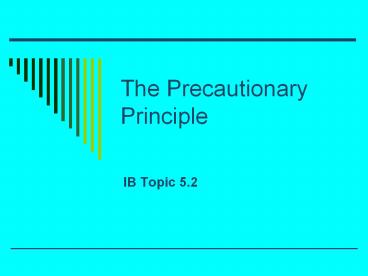The Precautionary Principle PowerPoint PPT Presentation
1 / 16
Title: The Precautionary Principle
1
The Precautionary Principle
- IB Topic 5.2
2
The precautionary principle
- The Intergovernmental Panel on Climate Change
(IPCC) - Created in 1988
- Find out if human activities have an impact on
climate - What do you think they found?
3
IPCC Findings
- 2007 their 4th report showed that
- Global temperatures are increasing
- Global warming is not a hypothesis but a
confirmed reality - There is a 90 chance increasing temperatures are
due to production of greenhouse gases by human
activity - Less than 5 chance due to natural causes
- Within the next 100 years, sea level is expected
to rise between 18 cm-59 cm - Likely severe weather will increase
- Heat waves, droughts, heavy rains
4
Warning signs lead experts to evoke the
precautionary principle
- Ethical theory
- Action should be taken to prevent harm even if
there is not sufficient data to prove the
activity will have severe negative consequences - Also, if people choose to engage in an activity
that may cause changes in the environment, they
must first prove it will do no harm
5
Without the precautionary principle
- Industries and consumers tend to proceed with
their activities until its obvious harm is being
done - With irrefutable proof, activity is usually taken
to reduce the activity in question
6
Example
- The use of DDT
- pesticide
- Prohibited in North America
- Proven to accumulate in ecosystems
- Reduce populations of birds of prey
- Bald eagle
7
Evaluating the principle
- Tenets of the precautionary principle say
preventative action should be taken now - Reduce greenhouse emissions/gas
- Before its too late
- Also say those who wish to continue producing
excess greenhouse gases - Should prove that there are no harmful effects
before continuing
8
The other side of the argument
- Farmers, manufacturers, transportation providers,
among others, wonder - Why invest in new techniques to reduce
greenhouse emissions if scientists are not 100
sure how an enhanced greenhouse effect is going
to be harmful to the environment
9
So,
- Unless preventative measures are taken across the
board by countries world wide - There will always be polluting competitors who
can offer products at a lower price - Capital vs. ecological measures
- Well informed consumers?
- Choose eco-friendly products
- What message does this send to companies?
- Are we seeing this today?
10
Turn and talk
- Suppose you want to buy a particular product.
You find what you want and the labeling says it
is produced using eco-friendly techniques. But
it costs 25 more than a similar product which is
not eco-friendly. Which would you buy? Why?
11
Prevention is better than cure
- Is money spent now on protective measures wasted
money? - Is it less expensive to prevent a problem than to
fix it? - In most cases yes
- We see this in health care, too
- Cheaper to screen for a disease, educate people
than to pay for treatment repercussions - Obesity
- 100 billion is spent annually on obesity
related issues in the US
12
Human impact on Arctic ecosystems
- Parts of North America, Greenland, Iceland,
Norway, and Russia - Changes
- More ice melting/year
- Less snow more frozen rain
- Mosquitoes!?
- Woody shrubs ? warmer soil
- Robins
- New species new pathogens
13
Consequences in the Arctic
- Changing ecosystems
- Intact ice allow algae to grow (attach to
underside, transparent to light, allow for
photosynthesis) - Ice melting less surface to stick to
- Less algae (producers) what happens to other
trophic levels?
14
And the polar bears
- Long swims need ice to rest
- Rely on seals as main food source
- Hunting techniques to stand on ice near a hole
and wait for seals to come up for air - Less ice what happens to this technique?
- Less food
- Cub population has decreased by 10 over the past
20 years
15
In conclusion
- Carbon is a super important element to the
biosphere - Must be recycled
- Levels are affected by
- Photosynthesis
- Respiration
- Combustion
- Feeding
- Decomposition
- Earths natural greenhouse is essential for life
- Its just intensifying
- Human activity
- Carbon dioxide, methane
16
For your test tomorrow
- 5.2
- Draw and label the carbon cycle
- How does carbon enter? Leave?
- Analyze changes in CO2 concentration
- Explain the greenhouse effect
- Outline the precautionary principle

